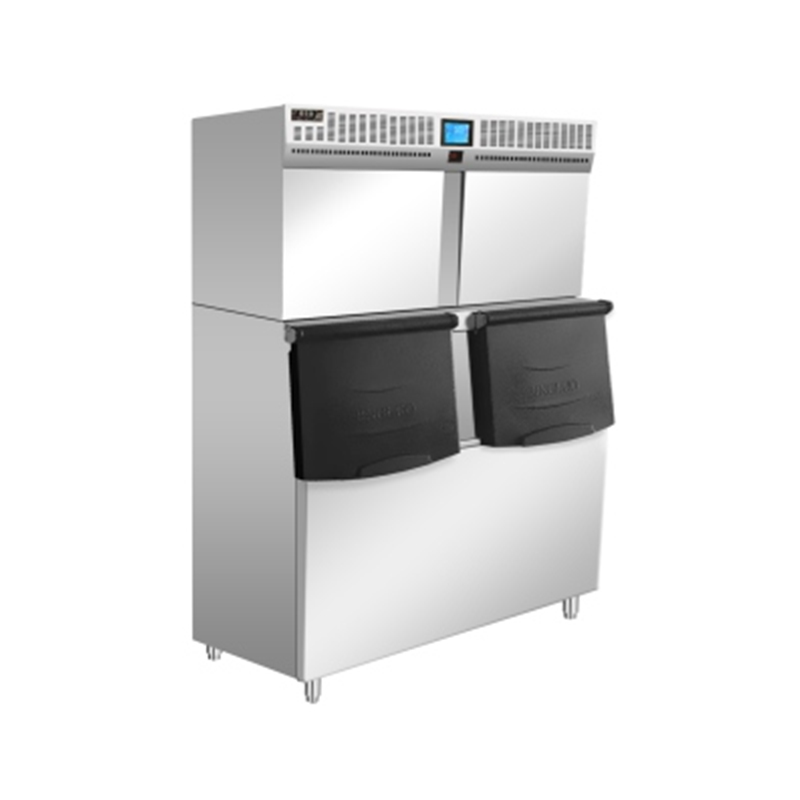2025-06-20
What is the difference between an ice machine and an ice maker?
Ice Maker
The term "ice maker" most commonly refers to:
1. Residential Refrigerators with Built-in Ice Production: This is perhaps the most common "ice maker" in many households. It's an integrated component within a freezer that automatically produces ice cubes and dispenses them.
Scale: Very small-scale production, suitable for a single family's daily needs.
Integration: Part of a larger appliance (the refrigerator).
Features: Basic ice production (usually crescent or half-moon shaped cubes), often with an ice dispenser.
Water Supply: Automatically connected to the home's water line.
2. Countertop or Portable Ice Makers: These are compact, standalone appliances designed for convenience and portability.
Scale: Small to medium-scale production, suitable for parties, small gatherings, RVs, boats, or supplemental ice at home. They typically produce 20-50 lbs of ice per day.
Installation: Very simple. Usually just plug it in and manually add water to a reservoir. No dedicated water line or drain needed for most models.
Ice Type: Often produce "bullet" shaped ice, which is cylindrical with a hole in the middle, or small nuggets. The ice can sometimes be cloudy.
Storage: Often have a small insulated bin to hold a limited amount of ice, but it's not a freezer and the ice will eventually melt if not transferred to a freezer.
Cost: Generally inexpensive and easily accessible to consumers.
Maintenance: Low maintenance, primarily involving cleaning the water reservoir periodically.
3. Under-counter (Residential/Light Commercial) Ice Makers: These are somewhat larger and more robust than countertop models, designed to be built into kitchen cabinetry, similar to a dishwasher.
Scale: Moderate production, often 30-100 lbs per day. Good for larger homes, small offices, or a home bar.
Installation: Requires a dedicated water line and a drain.
Ice Type: Can produce clearer ice cubes, crescent ice, or gourmet ice (clear, slow-melting cubes).
Storage: Often have a larger internal bin for storing ice.
Cost: More expensive than countertop models but less than commercial machines.
Maintenance: More involved than countertop models due to water line connection, but still relatively straightforward.
In essence, an "ice maker" typically implies a consumer-oriented device, often integrated or designed for convenience and relatively lower volume ice production for personal or small-scale use.
Ice Machine
The term "ice machine" most commonly refers to:
Commercial/Industrial Ice Production Units: This is the primary and most significant use of the term. These are large, heavy-duty appliances built for continuous, high-volume ice production in commercial settings.
Scale: High-volume production, ranging from hundreds of pounds (e.g., 200 lbs/day) to thousands of pounds (e.g., 2000+ lbs/day) of ice. Essential for businesses that depend on a constant supply of ice.
Application: Found in restaurants, bars, hotels, hospitals, convenience stores, cafeterias, fisheries, construction sites, and large event venues.
Design: Often modular, consisting of an "ice head" (the part that makes the ice) and a separate "ice bin" (for storage). Sometimes they are "self-contained" where both are in one unit, but even those are generally robust.
Installation: Requires professional installation with dedicated water lines, proper drainage, and often specific electrical wiring and ventilation.
Ice Type: Produce a wide variety of ice types tailored for specific commercial needs:
Cube Ice: Full cube, half cube (very clear, slow-melting, ideal for drinks).
Nugget Ice (Chewblet): Soft, chewable ice, popular in fast-food and healthcare.
Flake Ice: Soft, moldable ice, used for displaying food (e.g., seafood), medical applications, or blending.
Gourmet/Top Hat Ice: Distinctive, slow-melting, very clear ice for high-end beverages.
Specialty Ice: Block ice, tube ice (for industrial cooling, chemical processes).
Storage: Requires large, insulated bins (often sold separately) designed for significant ice storage. These bins are not refrigerated; they are designed to minimize melting.
Cost: Significantly more expensive upfront, with higher operational costs (electricity, water) and maintenance.
Maintenance: Demands rigorous and regular maintenance (cleaning, descaling, filter changes, sanitization) to ensure hygiene, efficiency, and longevity, often performed by professional technicians.
Durability: Built for continuous operation and a much longer lifespan (10-15+ years) under heavy use.
In essence, an "ice machine" implies a robust, high-capacity, commercial-grade appliance designed for professional and industrial environments where a large, consistent, and specific type of ice is critical for business operations.
Analogy:
Think of it like this:
- An "ice maker" is like a coffee maker you have at home – convenient, serves your personal needs.
- An "ice machine" is like a commercial espresso machine in a busy cafe – large, specialized, high-volume, and essential for business.
While the fundamental function (making ice) is the same, the scale, engineering, durability, cost, and intended user experience are significantly different.


 English
English русский
русский Español
Español عربى
عربى






